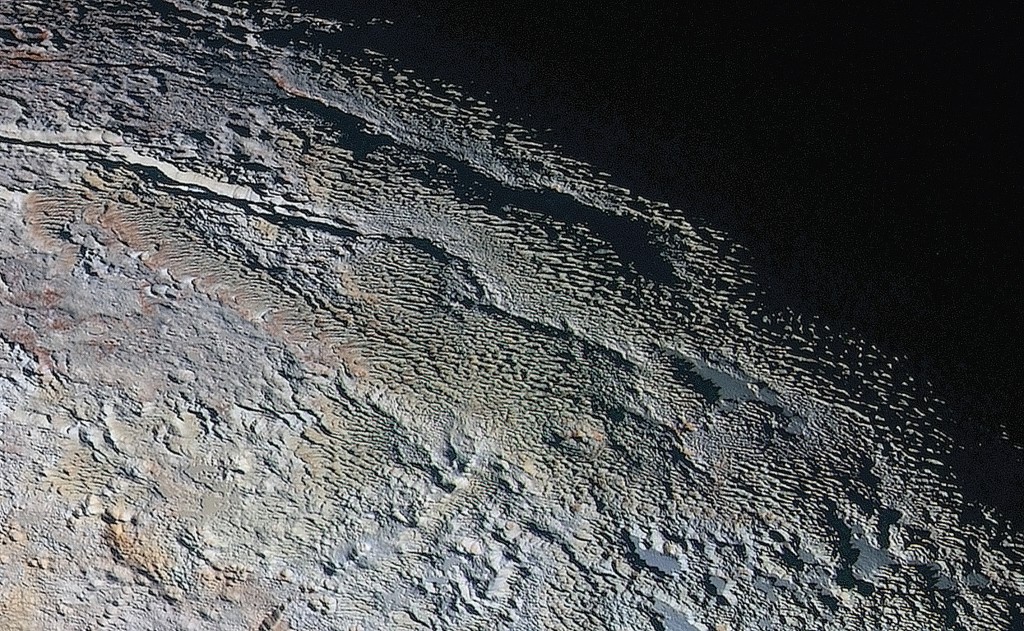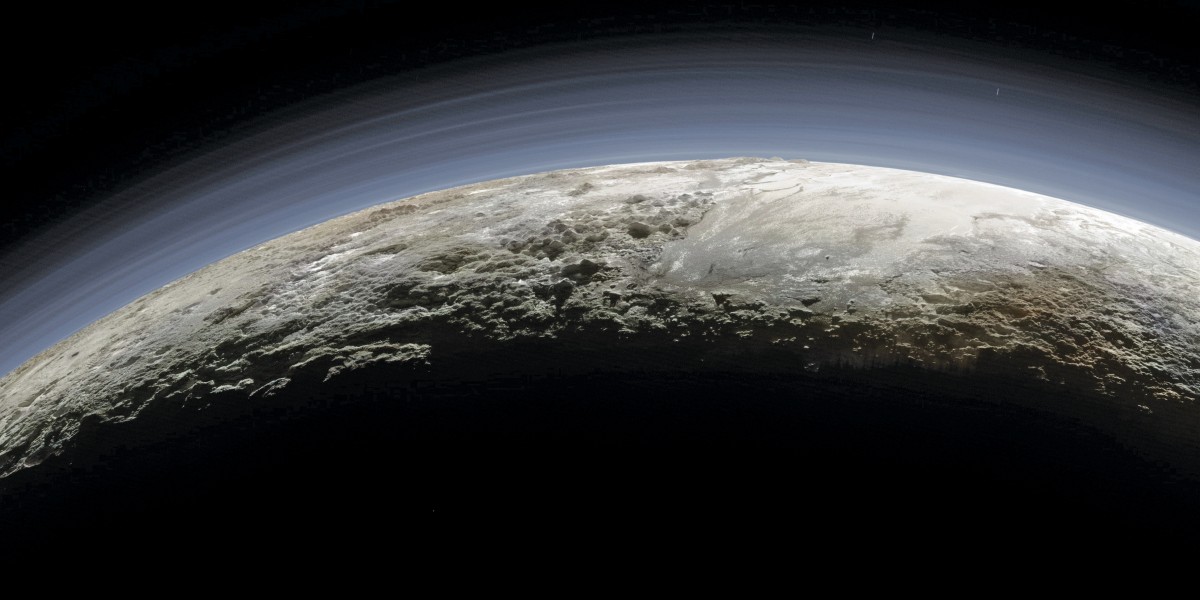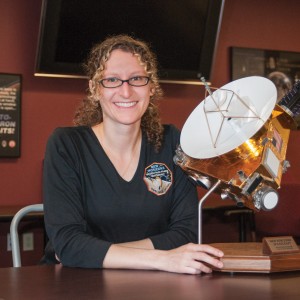On July 4, 2015, at 1:54 p.m. EDT, the New Horizons spacecraft suddenly fell silent.
It was a heart-stopping moment. The spacecraft, having spent more than nine years barreling through space, was only 10 days out from its flyby of the Pluto system.
New Horizons was carrying seven scientific instruments; a pinch of the ashes of Pluto’s discoverer, Clyde Tombaugh; a CD with the names of 430,000 Pluto fans — and the hopes and dreams of 35 scientists who had been waiting nearly half a lifetime to lay eyes on the ninth planet in the classical solar system.
Since plans for the mission had been originally made in 1989, planetary scientist William McKinnon, PhD, had married and raised three children, the youngest of whom is now a senior in high school, and bought and sold more than one home. Planetary scientists, commentators pointed out, are people who will work for delayed — very delayed — gratification.
“On Independence Day, the science team had the day off and was basically in barbecue land with the rest of America,” says McKinnon, professor of earth and planetary sciences in Arts & Sciences. “I was at my sister’s in Pennsylvania when I got the call that the spacecraft had ‘safed.’”
The spacecraft had fallen silent while it was loading the “core encounter program,” the all-important sequence of maneuvers it would execute as it zipped through the Pluto system at 30,000 miles per hour. What had gone wrong?
Within 30 minutes, an engineer at mission control at the Johns Hopkins University Applied Physics Laboratory in Laurel, Maryland, not panicking, said, “I think I know what happened.” The primary computer had been uploading the core encounter, which was being radioed from Earth, at the same time it was compressing all the data that had already been taken into flash memory so that the regular memory deck would be clear for the flyby.
The clock slowed a little, because there was too much going on, an “autonomy rule” tripped, and the spacecraft safed — meaning it started spinning so that it could maintain its orientation in inertial space and point its antenna at Earth.
But this was supposition. If it were true, the “A-side” computer would switch control to the “B-side” computer, and the spacecraft would call home in 30 minutes or so. “And that’s exactly what happened,” McKinnon says. “All of a sudden it radioed, in effect, ‘Hello? What should I do?’”
So by the time McKinnon knew there was a crisis, the immediate crisis was over. “But we weren’t exactly sure what had happened. So we had an anxious evening and light sleep. But nothing indicated disaster — yet,” he says.
“Nevertheless, nothing was taken for granted from that point on.”
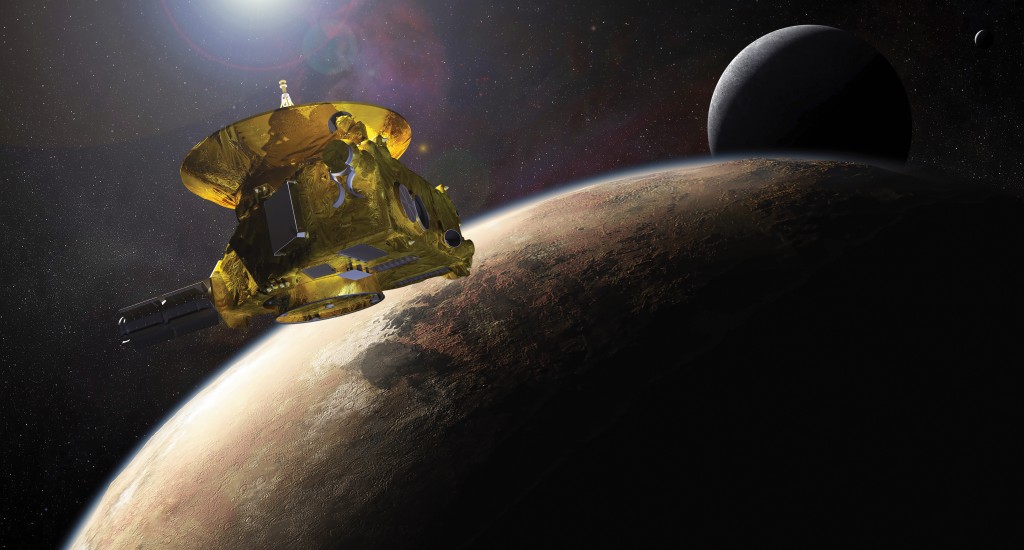
It took three days to write new code that would allow the spacecraft to rejoin the original timeline, to rigorously test the code on hardware simulators and to upload the core program again — tasks made more nerve-racking because of the 4.5-hour one-way travel time to Pluto at the speed of light.
The timeline was important because the spacecraft was about to attempt an elaborate series of rapid-fire pirouettes across the dance floor of the Pluto system. If it was off the mark, the instruments would be snapping photos and taking measurements of empty space rather than of Pluto and its moons.
So there was much rejoicing in Maryland when the screens at the Applied Physics Laboratory showed a zero turning over to a one, indicating that the core sequence had loaded and was beginning to execute.
“We were watching a whole bunch of numbers and words on a screen,” McKinnon says. “And there was one digit that was going to turn from a zero to a one. It was just one little digit. But it was going to say that the core sequence was now running. It was a great moment when that digit flipped.”
Seven days later, the signal dropped again — but this time it was by design. For the 22 hours on July 14 when New Horizons flew through the Pluto system, the spacecraft ran itself in order to upload data and images without interruptions.
As the big “Closest Approach Countdown Clock” ticked down to zero at the Applied Physics Laboratory, people were cheering and waving flags. But it was an “existential celebration,” McKinnon says, “because we had no idea whether the spacecraft had survived or was doing anything properly.”
In the evening, folks gathered as closely as they could to mission control because at 9 p.m. EDT the spacecraft was supposed to turn toward Earth and send back some engineering data saying it was alive, it had survived.

At 8:52 p.m. EDT, Alice Bowman, the missions operations manager (otherwise known as MOM), took a call coming in over the Deep Space Network, listened intently as various subsystems reported in (such and such was “nominal”), and then turned to tell the team: “We have a healthy spacecraft, we have recorded data from the Pluto system, and we are outbound from Pluto.”
“That was the emotional high point of the mission,” McKinnon says.
“New Horizons even reported the right number of thruster counts,” he says. “Because the encounter sequence is choreographed, having the right count was like saying the dancer took the requisite 8,000 steps for the ballet. So we knew the whole ballet had occurred.”
The next day, July 15, the first images of the close encounter of the new world started to come down, and things got a bit crazy. “Were you like kids in a candy store?” a reporter asked McKinnon. “More like lunatics in an asylum,” McKinnon replied.
Please, no craters
It is worth remembering how little was known about Pluto before this flyby. Scientists knew Pluto’s size (roughly), its density (also roughly) and that it had a nitrogen atmosphere. The Hubble telescope had taken some very fuzzy photographs of the object, which had been turned into a GIF that showed off Pluto’s strong colors and albedo patterns.
Together, this wasn’t much to go on. But McKinnon had made the icy bodies of the outer solar system his special field of study.
He had begun as a student of the rocky inner planets, because that’s where NASA sent its first voyages of discovery. But as luck — or fate — would have it, NASA’s Voyagers reached Jupiter and its moons in 1979 when he was still a graduate student, training in planetary science and geophysics.
“I then got a postdoctoral research appointment with one of the Voyager imaging team scientists when the spacecraft reached the icy moons of Saturn, and we saw them for the first time,” he says.
“The sheer strangeness of these places, which became real worlds once we could see them, was fascinating to me. So I more or less left the rocky inner worlds of the solar system behind and focused on the icy satellites of the outer solar system.”
Thirty years later, having studied Io, Europa, Ganymede, Callisto, Enceladus, Iapetus, Titan and Triton, among others, he had seen a lot of exotic ice worlds, none like the others and none boring. When the website Astronomy Picture of the Day published a “last guess” of what Pluto would look like a month before the flyby, McKinnon took one look and said he would be very disappointed if the guess was right.
The problem was there were so many craters everywhere, he says, which means that a planet is most likely dead, a scarred relict of early periods of heavy bombardment.
In fact, many scientists expected Pluto to be (mostly) dead. NASA press releases going into the encounter called Pluto a “time capsule from the early solar system,” implying the dwarf planet died 4 billion years ago and was sort of a space mummy.
The argument was that Pluto was so small that it should have lost the primordial heat from its accretion, and the heat given off by radioactive elements in its interior would be feeble. No heat = no activity = no interesting geology.
But McKinnon was on record predicting Pluto would be a living planet. “Anybody who thinks that when we go to Pluto, we’re going to find a cold, dead ice ball is in for a rude shock,” he had said. McKinnon was hoping to see a very active and dynamic world.
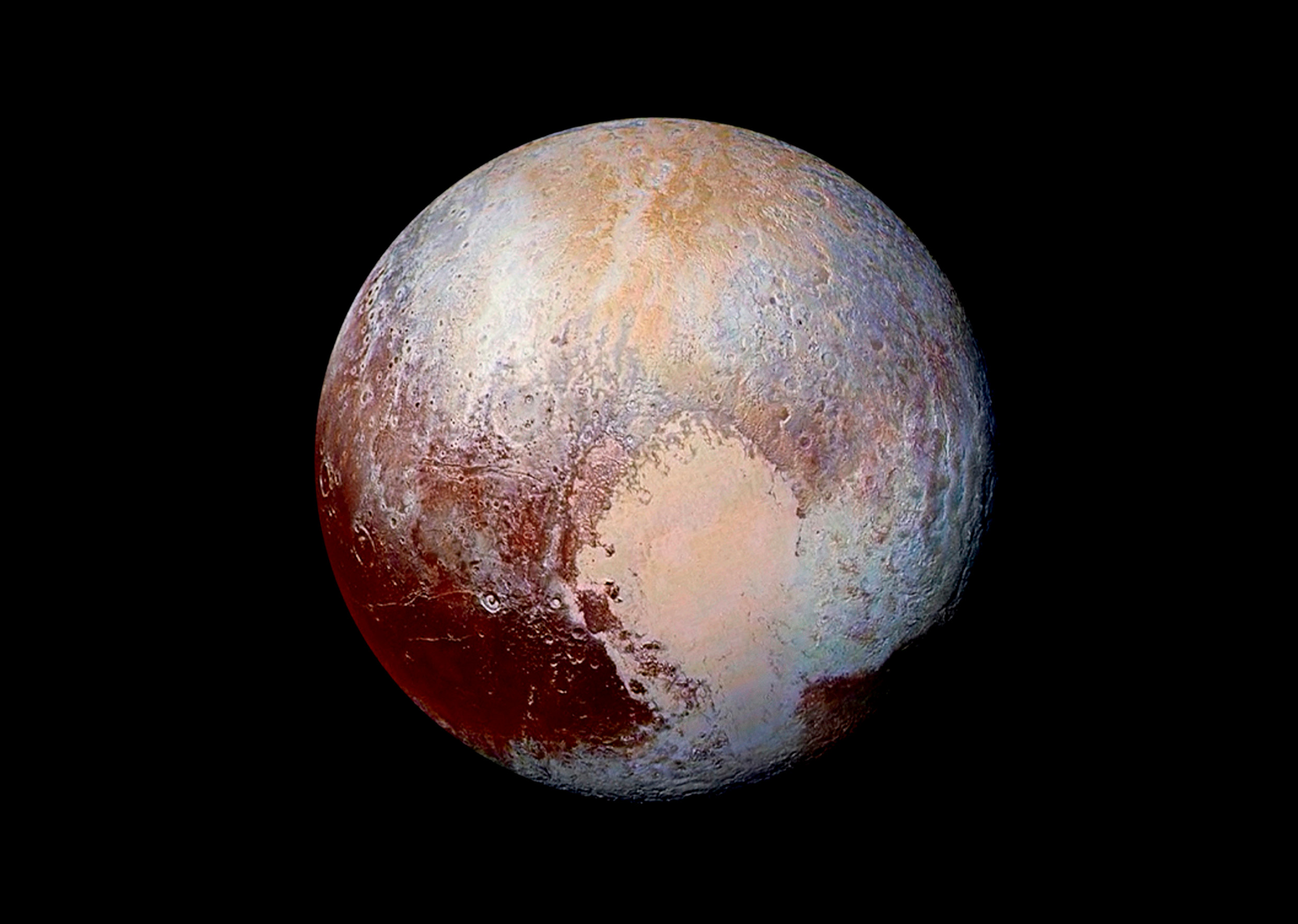
“I expected Pluto to resemble Triton, Neptune’s big moon,” he says. Triton has volcanic calderas, geyser-like eruptions and mysterious cantaloupe terrain.“We think Triton is a captured Kuiper Belt Object like Pluto,” McKinnon says. “It has the same density, the same bulk composition, the same surface ices as Pluto. They’re — well, not twins, not siblings — maybe kissing cousins.”
So the bets had been placed. Rien ne va plus, as the croupier says. And then July 13, just before beginning the flyby, New Horizons sent down the last “fail-safe” image of Pluto in case something adverse happened during the 22-hour close encounter.
The data showed it wasn’t Triton, but it wasn’t a cold, dead ice ball either.
The feature that drew all eyes was the “heart,” the left side of which was spectacularly uncratered. To be so smooth, this terrain had to be very young, at most 100 million years old, which meant that Pluto was geologically active or, at the very least, had been recently.
On July 15, the first detailed images of the heart — the heart of the heart — came down.
At the next NASA news briefing, McKinnon put up an image of the edge of the “left ventricle” of the heart, provisionally called Sputnik Planum.
“We think the heart is a basin filled with solid — probably mostly solid — nitrogen and other volatile ices that are maybe miles thick,” McKinnon says.
“The streamlines, which I’ve marked with curved arrows, look just like glacial flows on the Earth. Water ice at Pluto’s temperatures [surface temperature averages minus 380 degrees Fahrenheit] is immobile and brittle; it’s not moving anywhere. But the nitrogen ice, carbon monoxide ice and methane ice that make up the Planum are geologically soft and malleable, and will flow in the same way that glaciers do on Earth.”
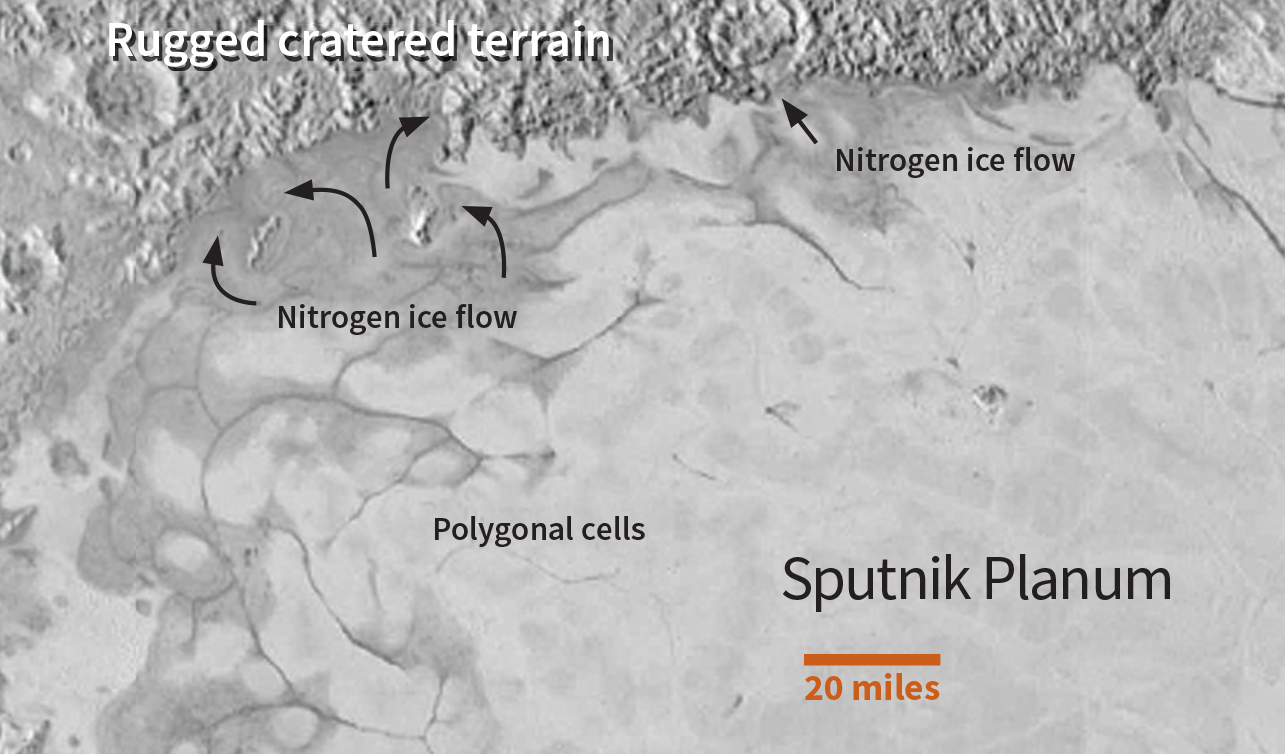
What are the polygonal cells? “Our leading model is that there is internal convection; the nitrogen ice slowly rises in the centers of the polygons as it warms and sinks along their boundaries as it cools. As long as the ice is at least a half mile deep, we think that process can operate.”
“That’s the lesson we learn over and over again … Nature’s imagination exceeds our own.”
William McKinnon
But what is driving the convection? “No need to invoke special mechanisms,” McKinnon says. “Pluto contains a lot of rock, more rock by mass than ice. And if you have rock, you have radioactive decay, and the heat will leak out.” He explains that it may not be a vast amount of heat, but it doesn’t take a lot of heat to mobilize nitrogen ice.
Despite the glitch on July 4, the spacecraft performed spectacularly, and Pluto really cooperated as well. “It could have been just a dead, cratered ball, but no. Not only is it living, it is unlike anything we’ve seen anywhere else in the solar system,” McKinnon says.
“So nature once again has trumped us with its cleverness. That’s the lesson we learn over and over again as we explore the solar system: Nature’s imagination exceeds our own.”
